Audubon’s 120th Christmas Bird Count — CBC — is close.
December 14, 2019 to January 5, 2020
Something to do with your holiday houseguests, friends and family while you earn volunteer hours! How fun is that?
Check it out: https://www.audubon.org/conservation/join-christmas-bird-count
I thought this would be a good time for fun with bird words.
Question: What do you call a group of vultures feeding around a carcass?
Answer: A wake! Truly! Google: collective noun for vultures
A group of vultures in flight formation is called a kettle — because they appear to look like a bubbling kettle.
Vultures are social birds. They’re often seen in groups on the ground or in trees and often roost together with black vultures at communal roosts — sometimes by the hundreds. At those times, they would be referred to as a venue, volt or committee of vultures.
This past week has presented several kettles of vultures. Hopefully there will be more to count for the CBC.
Lately the sky over the resaca on our property has presented a lot of birds: squadrons of pelicans, rushes of whistling ducks, undulating clouds of blackbirds, possibly a couple of gulps of swallows, canteens of spoonbills, congresses of cormorants and wedges of egrets — but no pandemonium of parrots.
Never mind — keep counting! To help us count, the Cornell Lab of Ornithology has given up their secrets in counting masses of birds. The easy way is to take a photo and then count them by hand. If you want to be professional about it, the below link describes how to count great masses of birds. It’s fascinating — if not intriguing — for those of you who love math, numbers and extrapolating! Check it out!
The Main Topic — Turkey Vultures
I’ve been researching turkey vultures this week. They’re pretty awesome when they’re soaring effortlessly on the thermals with their wings out-stretched.

Up close, yeah, well, a bit disconcerting with their bare-skinned red heads and warts.
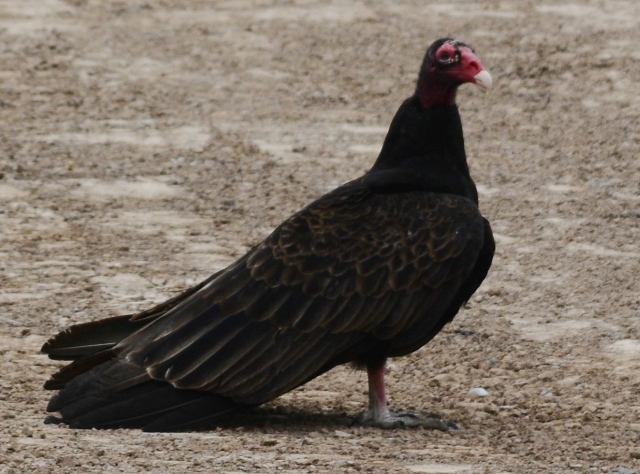
Turkey vultures are a permanent Valley resident, and they’re joined for the winter by scads of migrating vultures. The turkey vultures are one of the largest birds that can be seen in the Valley skies. They have a wingspan of six feet. On the ground, they stand more than two feet tall.
They’re feathers are brown, not black.
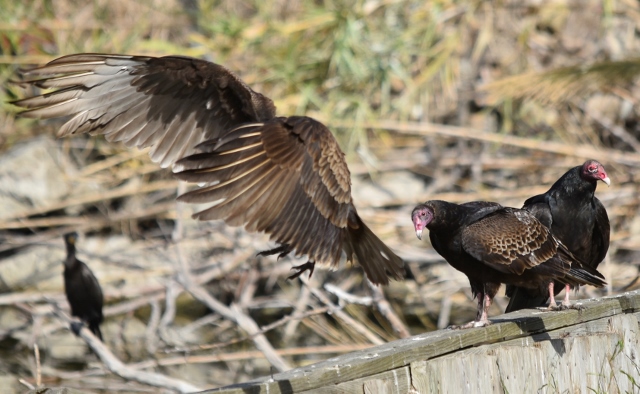
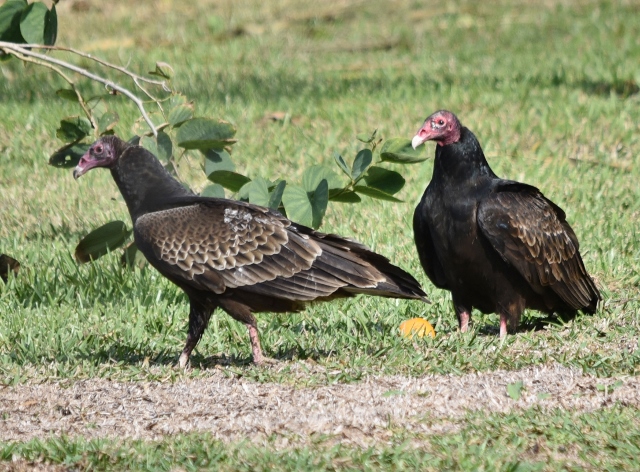
Vultures are not buzzards. The buzzard is a real bird. It is the “commonest and most widespread United Kingdom bird of prey. It is in the Accipitridae family. The common buzzard species is Buteo buteo. Its range is quite large, in most of Europe, extending into Asia and mainly western Russia. . . . Their plaintive mewing call could be mistaken for a cat,” according to rspb.org.uk, the Royal Society for the Protection of Birds.
Vultures are in the Cathartidae family. The Turkey vulture is Cathartes aura.
Not everyone appreciates turkey vultures, although they should. These carrion scavengers perform a much-needed environmental service. Their scavenging ways help prevent the spread of diseases such as rabies and tuberculosis by clearing away carcasses.
The vultures themselves are remarkably resistant to most diseases, especially those likely to be present in carrion. They also have the ability to use a process called urohydrosis, whereby an animal urinates on itself in order to cool down in extremely hot temperatures. Vultures use this process to disinfect their legs of bacteria after feeding on a rotten carcass. Their urine has high levels of acid.
Their stomachs have high levels of acid, too, which helps the birds destroy lethal bacteria during digestion and break down ingested bones. Bones constitute 70 to 90 percent of their diet, which consists almost entirely of animal remains.
There’s an opportune time as far as road kill — the fresher the better. They won’t eat extremely rotted carcasses. They do eat garbage, often frequent landfills, and will eat vegetables, like pumpkin, if there is a food shortage. Turkey vultures are unable to carry off their carrion. Their feet are chicken like, not talon-like as hawks. Their beak can pierce through the toughest cow hide, though.
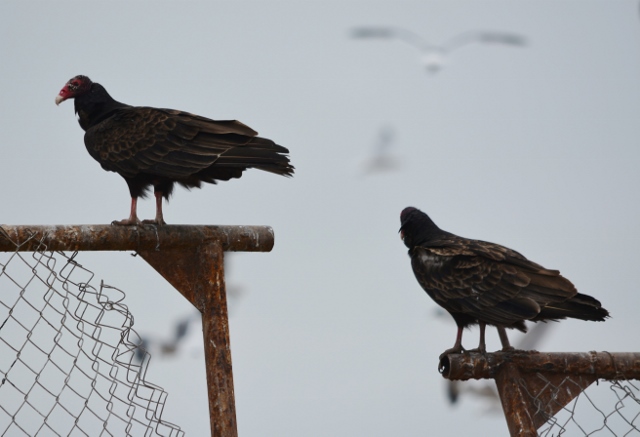
One of the very few birds that can smell, turkey vultures can smell carrion less than 12-24 hours old. They also detect by sight, but rely heavily on their sense of smell. They can sniff out a dead critter from more than a mile away, and locate a dead rat hidden under a pile of leaves. They’ve been known to cruise 30 to 50 miles in search of food. They are more likely to search out food away from urban areas.
Adult vultures have little fear from predators; interestingly, not much eats a vulture carcass, not even vultures, unless food is scarce.
Turkey vultures possess an unusual defense mechanism, they can regurgitate their last meal — apparently a worse smell than decaying meat — which is effective against any predator with a sense of smell.
Black vultures, also are permanent Valley residents. They can be distinguished in flight from turkey vultures by their short, squared tail feathers that barely extend beyond the wing; their feet often protrude beyond the tail.

Just for fun: Wingspan Comparisons
The length of a bird is generally the body length from crown to feet or to tip of tail, depending on where the longest measurement will be when the bird is standing or perched.
Wingspan, a much more dramatic measurement, is from the very tip of one wing to the very tip of the other wing when the wings are held outstretched.
The largest flying bird ever was an extinct species called Argentavis magnificens, which existed more than 6 million years ago. It is believed to have had a wingspan of 23 to 30 feet — two to three times larger than the wandering albatross — the bird currently considered to have the longest wingspan — at 11.5 feet. The wandering albatross is found in Southern Ocean, also called Antarctic Ocean, the southern portions of the Pacific, Atlantic and Indian oceans and their tributary seas surrounding Antarctica.
On land, the title of largest bird is said to be jointly held by the Andean condor in South America, and the Marabou stork, that lives in Africa, south of the Sahara. They each have a wingspan to 10.5 feet.
The shortest bird wingspan is the bee humming bird of Cuba, with a 1.5-inch wingspan.
Below are comparison wingspans of the largest birds you’re likely to see flying the skies of the Rio Grande Valley:
American white pelican — 9 feet

Brown pelican — 7 feet
Great Blue Heron — 6.4 to 6.8 feet
Osprey — 6 feet — often seen at Port Isabel’s Queen Isabella Causeway with pelicans

Turkey vulture — 6 feet
Black vulture — 5 feet
Red-tailed hawk — 4.83 feet
Crested caracara — 4 feet — often scavenges with vultures
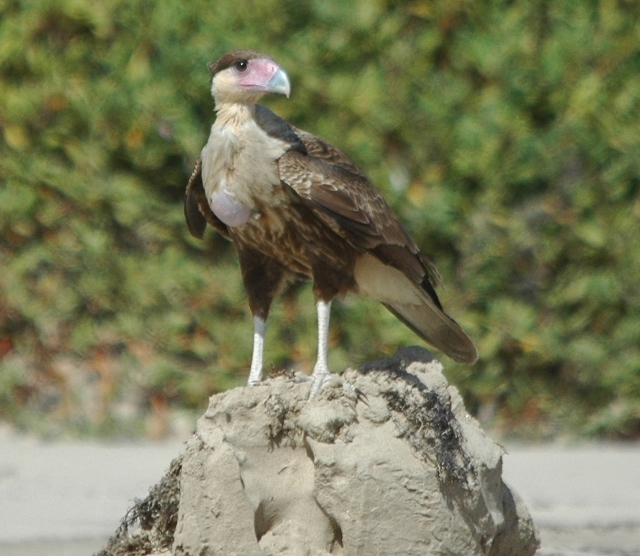
A couple of newsletters you can sign up for:
Cornell Lab of Ornithology cornellbirds@birds.cornell.edu
Team eBird eBird@cornell.edu
Sources: Planetsave.com, nytimes.com, Wikipedia, Britannica.com, Nationalgeographic.com, earthtouchnews.com, whateats.com, peregrinefund.org, allaboutbirds.org and Alsop, III, Fred J., Smithsonian Handbooks, “Birds of Texas,” DK Publishing, Inc. 2002.

Leave a Reply